The thought of cars driving themselves might seem like something straight out of a science fiction movie. But with advancements in artificial intelligence (AI), we are rapidly approaching a future where self-driving cars could become a common sight on our roads. This raises an intriguing question: Will we still need driver’s licenses in a world dominated by AI-powered vehicles? Let’s explore this topic and discover what it means for our future.
The Rise of Self-Driving Cars
Self-driving cars, also known as autonomous vehicles, are designed to navigate and operate without human intervention. They use a combination of sensors, cameras, and AI algorithms to understand their surroundings and make decisions in real-time. Companies like Tesla, Google (with Waymo), and many others are heavily investing in this technology, showcasing prototypes that have already hit the streets.
Imagine hopping into a car, typing in your destination, and letting the car take you there while you relax, read a book, or even take a nap. This is the exciting promise that self-driving cars hold. But as these vehicles become more prevalent, we must consider the implications for our current transportation systems, including the role of driver’s licenses.
A Shift in Responsibility
One of the most significant changes that self-driving cars bring is a shift in responsibility. Currently, when you drive, you are responsible for the safety of the vehicle and its passengers. But if an AI system is in control, who takes the blame if something goes wrong? This leads to the question of liability: Is it the driver, the car manufacturer, or the software developer?
As we navigate this new landscape, it may become necessary to rethink the concept of a driver’s license. Instead of being a certification for human drivers, it could transform into a permit to use autonomous vehicles. This would focus more on understanding the technology and how to interact with it safely, rather than mastering the art of parallel parking.
The Role of Regulation
With any new technology, regulation becomes critical. Governments will need to create laws and regulations that address the use of autonomous vehicles. This includes defining whether a driver’s license will still be necessary and how the operation of these vehicles will be monitored.
Consider how regulations around cars have evolved since the invention of the automobile. Initially, there were very few rules governing car use. Over time, governments introduced traffic laws, licensing requirements, and safety regulations to protect drivers and pedestrians. The same evolution will likely occur with self-driving cars, but with a focus on the technology that powers them.
The Future of Driving
As we look toward the future, it’s essential to consider how self-driving cars might change our lives. With the convenience of AI-assisted travel, we may see a reduction in traffic accidents caused by human error, which accounts for approximately 94% of all car crashes. This means safer roads for everyone, particularly vulnerable groups like children and the elderly.
However, the transition to an AI-driven transportation system will not be instantaneous. There will be a period of coexistence between human-driven and autonomous vehicles, and during this time, having a driver’s license will still be relevant for those who prefer to take the wheel themselves.
The Social Impact
Beyond safety, self-driving cars have the potential to reshape our cities and communities. With less need for parking spaces, urban areas could be redesigned to prioritize green spaces and pedestrian-friendly environments. Imagine walking through a park instead of navigating a crowded parking lot!
This shift could also democratize transportation. Individuals who cannot drive due to age, disability, or other factors may gain newfound independence with access to self-driving cars. This could improve their quality of life and open up opportunities for employment and social engagement.
Education and Adaptation
As we embrace an AI-driven future, education will play a vital role. Schools and organizations will need to adapt their curricula to include information about AI, its benefits, and its challenges. Understanding how these technologies work is essential for everyone, not just future engineers and programmers.
It’s also crucial for current drivers to familiarize themselves with the capabilities and limitations of self-driving cars. Knowledge about how to interact with these vehicles, recognize their signals, and understand their behavior will be essential for safe coexistence.
Conclusion: A New Era of Transportation
The question of whether we will need driver’s licenses in an AI car future is complex and multifaceted. While traditional driving skills may become less relevant, the need for understanding and interacting with autonomous vehicles will remain crucial. As society navigates this transition, we must prioritize safety, accountability, and education.
The future of transportation is bright with the potential of AI. Imagine a world where you can travel safely and efficiently, with reduced traffic accidents and a more inclusive society. While we may not have all the answers today, one thing is certain: the journey toward an AI-driven future is just beginning, and it promises to be an exciting ride!


